My last article on habitat gardening introduced some basics and exciting things I learned about beneficial insects in gardens. This was after attending an all-day Habitat Gardening workshop given by Frederique Lavoipierre, Director of Education at the Santa Barbara Botanic Garden. This column delves into bees, butterflies, and the importance of our moths, wasps and flies, plus tips and favorite plants for attracting beneficial insects.
Native bees – and flies– as pollinators
Everyone thinks of the European honeybee when they think of pollinators, but many native bees are as good or better pollinators. (The mason bee is one that’s better.) There are a whopping 1600 different species of native bees in CA. Nearly three-fourths nest in the ground so it’s good to keep some bare, unmulched ground on your property to attract them.
“There are lots of articles on how to help the European honeybee but we need to protect the native bees, and that’s by planting more native plants,” Lavoipierre said. She said bumblebees are a particularly overlooked and critically important pollinator and are decreasing in number.
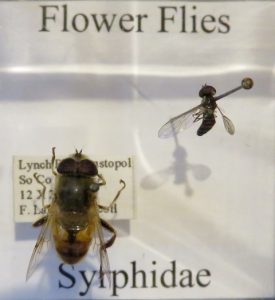 Flies: After bees, flies are the second best pollinators, with syrphid (Syrphidae) or flower flies a common one. As mentioned last column, beneficial insects seek both flowering plants and prey. Lavoipierre recommended keeping some aphids on your plants — milkweed being a good supplier of aphids — to keep these flies and other beneficial insects around.
Flies: After bees, flies are the second best pollinators, with syrphid (Syrphidae) or flower flies a common one. As mentioned last column, beneficial insects seek both flowering plants and prey. Lavoipierre recommended keeping some aphids on your plants — milkweed being a good supplier of aphids — to keep these flies and other beneficial insects around.
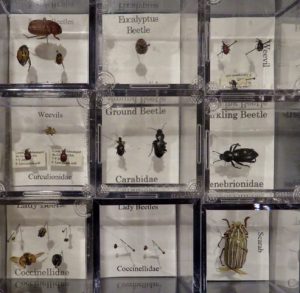
A few beetles are pollinators, while some like soldier beetles are beneficial insects that eats pests. Beetles live in the top layers of the soil where it interfaces with leaf litter so it’s best to not disturb that layer much. They’re also good decomposters.
Don’t Forget Caterpillar Gardens – and Moths
Butterflies, though generally not good pollinators, are always popular. Who doesn’t like a butterfly garden? But how many of us ask about caterpillar gardens? Butterflies first have to be caterpillars, which have vital relationships to their host plants. Lavoipierre emphasized the need for native plants because while some have found exotic host plants, most thrive best on native plants for their larva.
“Exotic plants produce far fewer caterpillars and consequently fewer butterflies and moths.” Frederique Lavoipierre
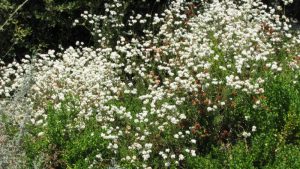
Most people know monarchs require milkweed plants (see below for Lavoipierre’s take on native vs tropical milkweed). Besides providing long-blooming flowers for nectar, buckwheats support a number of butterfly caterpillars, including the Acmon blue and Common hairstreak. The Acmon blue will also use deerweed or locoweed, while the American painted lady likes yarrow, mugwort or California sagebrush. The beautiful Giant swallowtail thrives in our area because citrus is an important host plant. For other species, many good websites can guide you to the appropriate host plants.
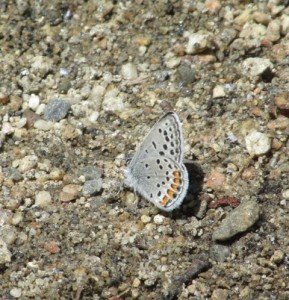
Lavoipierre also talked up moths, saying they’re “sadly neglected in the garden. Some moth species have been among the worst pests in agriculture, however for most moths, damage is usually difficult to detect.” Plus, she refers to moth gardens as “bird banquet gardens, because they are a critical bird food, especially in the spring when adults feed their young.”
Butterflies generally fly during the day and are more brightly colored than moths – but not always. Spectacular moth species include the Ceanothus silkmoth. Ceanothus, coffeeberry, gooseberry or manzanita are all host plants that will attract them. Other noteworthy ones are the woolly bear caterpillar, which becomes the tiger moth, while the hated tomato hornworm is the caterpillar stage of the beautiful sphinx moth.
Native or tropical Milkweed?
Lavoipierre also discussed the milkweed issue with monarchs – should we plant non-native tropical milkweed, which I can attest grows super well, better than most of my native milkweeds. Lavoipierre discourages tropical milkweed for two main reasons: tropical milkweed doesn’t die off in much of California, and allows disease to build up in monarch populations. And because it blooms year round, it’s changing their normal cycle. “Cutting down the tropical milkweed in the winter helps, but how many people remember to do this for every milkweed on their property?” she asked.
Garden Features to Attract Beneficial Insects
During the workshop Lavoipierre discussed garden features that support Conservation Biological Control (CBC), an important component of habitat gardening. CBC differs from classical biological control, where exotic enemies are imported such as the parasitic wasp for the Asian Citrus Psyllid. (Click here for my article on beneficial insects and ACP) Instead, it involves modifying the environment to protect and enhance resident natural enemies.
“CBC is less expensive and avoids the use of chemicals,” she said, and also creates a positive feedback loop where the pest populations are reduced more slowly, and thereby keep the natural predators around. That means it requires more patience.
An important feature to promote CBC is structural complexity, “where you offer different habitats ranging from grasses to trees.” Yards need grasses, shrubs of various sizes, trees and hedges. She explained that the habitats will vary each year, giving rise to varying populations of beneficial insects; for example, last year was a great year for ladybugs. I agree, having had a large California buckwheat that served as a productive ladybug nursery last summer in our front yard.
Having many insect species and also having them in abundance are also key features. Plus, offer habitat islands and corridors so there’s connectivity. “Plant in patches so insects can move quickly and easily for more prey and flowers. And having hedges and edges increases the number of insect species,” Lavoipierre said.
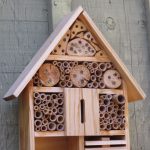
Lastly, beneficial insects need water and shelter. For shelter, she recommends permanent mulch, grasses, and letting logs decompose, advising people to ‘not be so neat’ or at least allow a portion of their yard to be a little messy where insects can shelter and overwinter.
As for ordering boxes of beneficial insects, such as ladybugs, she discourages it because the ladybugs do their job and then move off. But she gave two exceptions. “Buying parasitoid wasps to protect heritage trees can be a good idea; also buying lacewings to establish a population can often be successful,” she said.
Favorite Native plants
Lavoipierre provided a list of her favorite plants for attracting pollinators and beneficial insects.
For long-blooming plants she recommended native asters, Verbena de la Mina, milkweed, yarrow and goldenrod. Her favorite shrubs were Catalina cherry, buckwheats, elderberry, California redbud, ceanothus, salvias, toyon, coyote brush (a good winter bloomer), and coffeberry, which she said doesn’t bloom long but attracts many insects. She also recommends native perennial bunch grasses such as purple three-awn, California fescue, deer grass and purple needlegrass.
Except for the verbena, all have done well on our property. And with the increasing number of insects and nesting birds on our Redlands property, I can attest they’re doing their job.
Another well-written article Linda. My only concern would be the issue with tropical milkweed. It is not the milkweed that attracts disease. Butterflies carry diseases. When they fly from plant to plant illness is spread by exfoliated cells that slough off in flight over milkweed plants. This can happen no matter which milkweed your monarch butterflies are visiting. Our waystation grows lots of native milkweeds mostly Asclepias fascicularis, Narrow-leafed milkweed. But we also grow tropical milkweed Asclepias curassavica. Tropical milkweed has a faster recovery time than the native milkweeds. Meaning the leaves will reproduce faster after caterpillars have eaten them. Tropical also offers more cardenolides, that would be the milkweed sap that comes out of the leaves when you break one off. This substance helps to defend against predators. Cutting back your milkweed in the fall also rejuvenates your plant and brings it back fuller in the spring. Also if tropical had the ability to change the monarchs life cycle, then they would never leave their overwintering sights in Mexico. Truth is in California we have monarchs that don’t leave our State. We also have monarchs that migrate to us from West of the Rocky Mountains. When butterfly mating season rolls around some of these butterflies commingle. Grow your milkweed conscientiously. Best way to avoid disease is to sanitize your butterfly eggs in a mild bleach solution. This step will kill pathogens on the outside of your eggs that were passed to the egg from an infected female monarch butterfly. A caterpillar’s first meal is its egg. Next step would be to also bleach all the milkweed you feed your caterpillars. Now, these steps take a very serious approach to being a steward and lending Mother Nature a helping hand. It’s like vaccinating your kids. Once a caterpillar is sick there is no cure. Off my soapbox now. You can check out facebook.com/CaliforniaButterflyLady for helpful tips on raising butterflies.
Thanks Monika, there are definitely different views on this issue and I appreciate your comments. It would be great if people sanitized their butterfly eggs but I’m not sure many will do that – me included I must admit!
Lots of opinions about tropical Linda. Some are true some are false. You are getting your opinions from a parrot group of a group of scientists who stands to gain financially from their opinions being accepted. Here is the factual facts, http://nababutterfly.com/wordpress/wp-content/uploads/2015/04/Tropical-Milkweed.pdf
Hi Craig, I do think there are different well-entrenched camps on this subject of tropical milkweed, which is rather sad. Right now, I have our tropical milkweed, which I cut down each winter, and also grow two types of native milkweed.
One comment on the article you provided – I’ve seen tropical milkweed growing very well in areas on the CA coast and have seen monarchs mating in the winter months around them. I did check in with Tom Meriiman of Butterfly Farms in Encinitas, who has commented on this subject in one of my posts – he is supportive of tropical milkweed and sells it along with native milkweed, and I asked for an update. He replied: “Nothing has really changed Linda. They did capture migrating eastern Monarchs a couple years ago and tried to bring them out of diapause with tropical milkweed but couldn’t.
Jaap De Roode is an Emory University researcher, check out his Ted Talk:
https://www.ted.com/speakers/jaap_de_roode
A Biologist we work with has run afoul of the Monarch research community because she argues, convincingly, that it OK to grow tropical milkweed in So. Cal. She has a PhD in Entomology.
Chip Taylor of Monarch Watch, who we work with distributing native milkweeds around the country grows and sells tropical milkweed. So do we.
So nothing has changed.
Best,
Tom Merriman